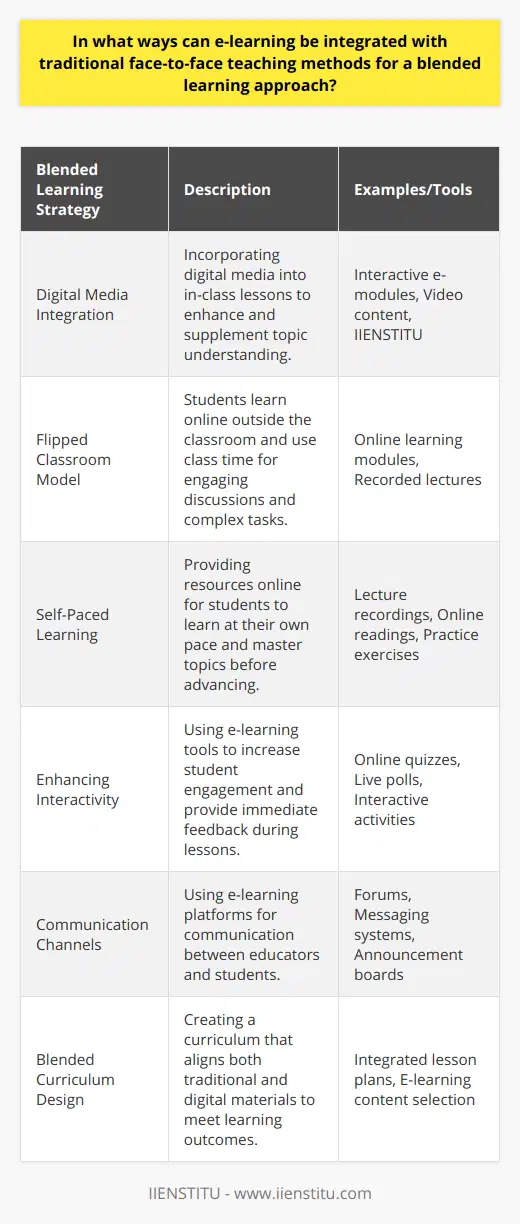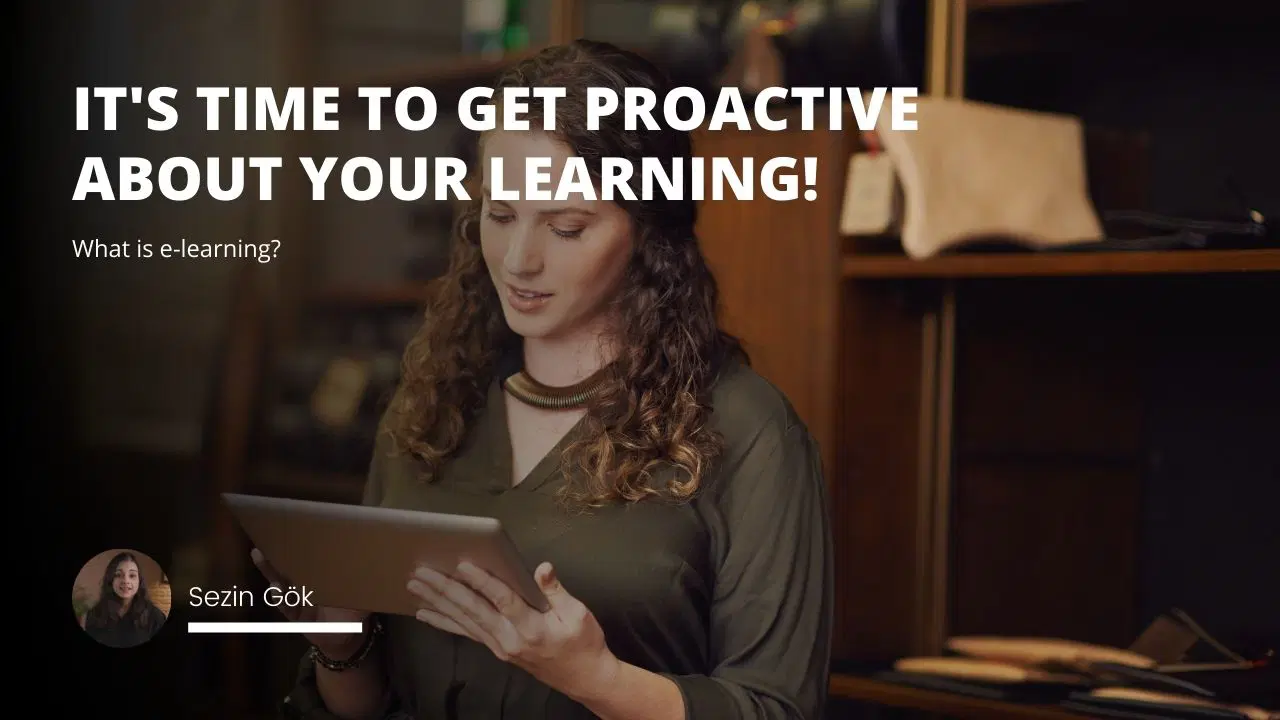
E-learning, also known as online learning, is a type of education that delivers course content and materials electronically. This can be done through various platforms and mediums, including the internet, mobile devices, and more. E-learning can be used for both formal and informal educational purposes.
So, what exactly is e-learning? E-learning is a flexible and convenient way to learn that can be tailored to fit each learner. It offers several advantages over traditional learning methods, such as increased flexibility, 24/7 access to courses and materials, and learning at one's own pace. Additionally, e-learning can be more cost-effective than traditional methods, as it eliminates the need for travel and other associated costs.
What are the critical features of e-learning? One of the essential features of e-learning is its interactivity. Online courses often use quizzes, videos, games, and other engaging content to promote active learning. Additionally, e-learning platforms typically provide learners with a high degree of control over their learning experience, allowing them to tailor the pace, format, and sequence to their individual needs and preferences.
Another essential feature of e-learning is its ability to connect learners with experts and other resources worldwide. Through online discussion forums, chatrooms, and other tools, e-learning allows learners to collaborate and learn from others in a way that is not possible with traditional learning methods.
There are several advantages of e-learning for both students and educators. For students, e-learning can provide increased flexibility regarding when and where they learn. It also offers the opportunity to learn at one's own pace, which can be especially beneficial for those with busy schedules or who need extra time to grasp concepts.
Additionally, e-learning can be more cost-effective than traditional methods, as it eliminates the need for travel and other associated costs. For educators, e-learning can offer a more efficient and effective way to deliver course content and materials. Additionally, e-learning platforms often provide a high degree of control over the learning experience, which can be beneficial for those who want to tailor their courses' pace, format, and sequence to their students' needs.
E-learning Meaning
E-learning, or electronic learning, is a type of instruction that delivers educational content directly to learners electronically. E-learning can take many forms, including online courses, software-based training, and webinars. E-learning is often used in conjunction with traditional classroom-based instruction, as it can provide a more flexible and convenient way for learners to access course material.
E-learning can also supplement face-to-face instruction, providing an additional layer of support for students. E-learning is an effective way to deliver content to learners of all ages and abilities and can be used in various settings, including schools, businesses, and government organizations. E-learning is a type of education that delivers course content and materials electronically.
E-learning is a type of education that delivers course content and materials electronically. It can be used for formal courses taught in a traditional classroom setting, or it can be used to provide more informal learning opportunities outside of the classroom.
E-learning can be delivered through various platforms, including learning management systems, e-mail, blogs, forums, and chat rooms. It can also create personalized learning experiences, such as online tutorials or adaptive e-learning courses that adjust to the individual learner's needs. E-learning has many benefits, including increased flexibility, improved access to education, and enhanced Learning Outcomes.
However, it is essential to consider the potential drawbacks of e-learning before implementing it in an educational setting. These drawbacks include a lack of personal interaction and the potential for technical problems. Nevertheless, when used effectively, e-learning can be a powerful tool for increasing access to education and promoting learning.
What are the benefits of e-learning for students and educators alike?
E-learning is an umbrella term that encompasses a variety of tools and methods used to deliver education electronically. This includes everything from online courses provided by universities to websites that offer self-paced tutorials on specific topics. E-learning has become increasingly popular in recent years, as students and educators have discovered its many benefits. This section will explore some of the key benefits of e-learning for students and educators alike. Stay tuned!
Increased flexibility and convenience - e-learning allows students to learn at their own pace and in their own time, without worrying about traveling to a physical classroom.
This type of learning also enables students to tailor their studies to their own needs and interests. In addition, e-learning is often more affordable than traditional forms of education, as it eliminates the need for travel and accommodation costs. As more and more people are increasingly pressed for time, e-learning is becoming an increasingly popular option for those seeking new skills and knowledge.
Improved engagement and motivation - with no need for traditional textbooks, educators can create more interactive and engaging lesson plans that keep students interested.
One of the main benefits of e-learning is that it is more flexible and convenient than traditional methods. Students can learn at their own pace and in their own time without worrying about traveling to a physical classroom. This flexibility is particularly beneficial for students who have busy schedules or live in remote areas. In addition, e-learning often costs less than traditional methods, as there is no need to rent or maintain physical space. As a result, e-learning is an attractive option for students and educators.
Enhanced accessibility - online courses are available to anyone with an internet connection, regardless of location or socioeconomic status.
The ubiquity of the internet has opened up a world of possibilities for education. No longer confined to traditional brick-and-mortar classrooms, learning can now occur anywhere there is an internet connection. This increased accessibility has had a particularly positive impact on those with limited economic resources or who live in remote areas. Through online courses, they now have access to educational opportunities previously out of reach.
In addition, online courses often offer a more flexible schedule than traditional classes, making them easier to fit into a busy lifestyle. As a result, online courses have made education more accessible.
More opportunities for personalization and differentiation - teachers can cater lessons specifically to each student's needs, interests, and abilities.
One of the significant advantages of online learning is that it offers far more opportunities for personalization and differentiation than traditional classrooms. Because teachers are working with students individually or in tiny groups, they can take the time to get to know each student's needs, interests, and abilities. They can then tailor their lessons specifically to those students, providing a level of support and challenge that is just right for them.
In addition, online learning platforms often offer built-in tools that allow teachers to customize their instruction further. For example, they might be able to assign different tasks to different students based on their skills level or choose from a range of assessments that better match each student's learning style. As a result, online learning can offer a more personalized and differentiated experience than traditional classrooms.
Greater collaboration among educators and students - e-learning promotes a collaborative environment where ideas can be shared and learned from one another.
In an e-learning environment, educators and students can collaborate more efficiently and effectively than in a traditional classroom setting. Ideas can be shared and discussed more openly, and students can learn from one another more informally. This type of collaboration can help to promote a more effective learning experience for all involved. In addition, e-learning can also help to reduce the barriers that often exist between different educational institutions. By promoting greater collaboration among educators, e-learning can help to improve the quality of education overall.
What are some of the challenges associated with e-learning, and how can they be overcome?
Some of the challenges associated with e-learning include a lack of personal interaction and the potential for technical problems. These challenges can be overcome by using e-learning platforms that offer opportunities for collaboration and communication and by ensuring that technical support is readily available.
Additionally, it is essential to consider the learning needs of individual students when designing e-learning courses, as not all students will learn in the same way or at the same pace. By catering to the unique needs of learners, e-learning can be an effective tool for promoting learning.
Lack of social interaction
e-Learning has become increasingly popular in recent years as it offers a flexible and convenient way to learn. However, one of the potential downsides of e-Learning is the lack of social interaction. Because learners are not physically present in a classroom, they can miss out on significant opportunities to interact with their peers and instructors. This can make it challenging to build relationships and discuss course material. While e-Learning does have its advantages, it's essential to be aware of the potential pitfalls before enrolling in an online course.
Difficulty staying focused
In an e-learning environment, it can be challenging to stay focused on the task at hand. Several factors can contribute to this, including distractions from other people in the virtual classroom, notifications from e-mail or other applications, and simply that it can be easy to get sidetracked when working from home. However, there are a few things that you can do to help improve your focus:
Try to create a dedicated workspace for yourself where you can minimize distractions.
Make sure to take breaks frequently and allow yourself time to move around and stretch; this will help you avoid feeling restless and improve your overall concentration.
Try to set realistic goals for each e-learning session and break them down into manageable tasks; this will help you stay on track and avoid feeling overwhelmed by the material.
You can improve your focus and make the most of your e-learning experience by following these tips.
Lack of motivation
e-learning can be a great way to learn new things, but it can also be quite challenging. One of the biggest challenges is staying motivated. It can be easy to get discouraged when you're not making progress as quickly as possible or when the material is difficult to understand. However, there are a few things that you can do to stay motivated and keep moving forward. First, set realistic goals for yourself and break the material into manageable chunks. Second, find a study buddy or group to help keep you accountable. Finally, make use of all the available resources, such as online forums and chat rooms. By taking these steps, you'll be well on your way to success in e-learning.
Difficulty retaining information
e-learning can be a great way to learn new information, but it can also be difficult to keep what you've learned. One reason for this is that e-learning can be repetitive and boring. If you're not interested in the topic, it can be easy to zone out and forget what you've read. Another reason is that e-learning can be overwhelming. When you're bombarded with new information all at once, it can be tough to process everything and remember it later.
Finally, e-learning can be distracting. With all the shiny buttons and videos, it's easy to get sidetracked and lose focus on the material. Luckily, you can do a few things to combat these problems.
First, try to find e-learning material that covers topics that interest you. If you're engaged in the material, you'll be more likely to remember it.
Second, take breaks often when you're e-learning. Getting up and moving around will help you stay focused and alert.
Finally, make sure to review the material regularly. Spacing out your learning will help solidify the information in your memory. By following these tips, you'll be able to overcome the challenges of e-learning and retain the information you need.
Technical difficulties
Technical difficulties are one of the most common problems associated with e-learning. Because e-learning relies on technology, many things can go wrong. For example, you might have trouble logging in to your course, or the audio might be choppy. While technical difficulties can be frustrating, there are a few things you can do to solve the problem.
Limited access to resources
One of the challenges of e-learning is that it can be difficult to access resources. If you're unsure where to find reliable information, you might feel lost and frustrated. However, you can do a few things to overcome this challenge:
Try using search engines like Google or Bing. You can use keywords to find websites, articles, and other resources that are relevant to your topic.
Take advantage of social media. There are a lot of great e-learning groups and communities on sites like Facebook and Twitter.
Don't forget about your library.
Many libraries have online databases that you can use to find reliable information for your studies. By taking these steps, you'll be able to access the resources you need for e-learning.
E-learning can be expensive
Another challenge of e-learning is that it can be expensive. If you want to access high-quality courses and materials, you might have to pay for them. However, there are a few ways you can save money on e-learning:
Look for free or low-cost resources. There are a lot of great free e-learning courses, materials, and websites available.
See if your school or library offers discounts on e-learning resources.
Consider using open-source materials.
These materials are released under an open license, which means they're free to use and modify. By taking these steps, you'll be able to find affordable e-learning resources.
E-learning can be time-consuming
Another challenge of e-learning is that it can be time-consuming. For example, if you're taking an online course, you might have to spend a lot of time reading, watching videos, and completing assignments. Additionally, you might have to schedule regular check-ins with your instructor or classmates. While e-learning can be time-consuming, there are a few things you can do to manage your time effectively:
Create a schedule and stick to it. By setting aside specific times for e-learning, you'll be able to stay on track and avoid getting overwhelmed.
Take advantage of tools like timers and reminders. These can help you stay focused and on task.
Don't be afraid to take breaks.
Taking breaks will help you avoid burnout and stay refreshed. By following these tips, you'll be able to manage your time effectively and make the most of e-learning.
You might feel isolated
One of the challenges of e-learning is that you might feel isolated. If you're not used to learning online, adjusting to being by yourself can be challenging. Additionally, you might not have the opportunity to interact with classmates or instructors in person. While isolation can be a challenge, there are a few things you can do to overcome it:
Try joining an e-learning community or group. This way, you'll be able to interact with other people who are going through the same experience.
Take advantage of technology. There are a lot of great tools that you can use to stay connected, such as video conferencing and instant messaging.
Make an effort to reach out to your instructor or classmates.
By taking these steps, you'll be able to combat isolation and feel more connected to your e-learning community.
You might not get the credit you deserve
One of the challenges of e-learning is that you might not get the credit you deserve. For example, if you're taking an online course, your grade might be based on a final exam or paper. This can be frustrating if you feel like you've put a lot of effort into the course but haven't been able to show it. Additionally, your instructor might not be familiar with the e-learning platform you're using, making it difficult to get the feedback you need. While these challenges can be frustrating, there are a few things you can do to overcome them:
Talk to your instructor about your concerns. They might be able to give you some guidance on how to best showcase your work.
Try to find a way to get feedback from classmates or other students. This can be done through online forums or groups.
Don't be afraid to ask for help.
If you're struggling with the material, reach out to your instructor or a tutor for assistance. By taking these steps, you'll be able to overcome the challenges and get the credit you deserve.
E-learning can be overwhelming
One of the biggest challenges of e-learning is that it can be overwhelming. It can be hard to know where to start with so many resources available. Additionally, there might be a lot of information to Absorb, making it difficult to focus. While e-learning can be overwhelming, there are a few things you can do to make it easier.
First, take some time to assess your needs. What are you hoping to learn? What do you need to know? By taking the time to answer these questions, you'll be able to narrow down your options and choose resources that are right for you.
Second, create a learning plan. By breaking down what you need to learn into smaller goals, you'll be able to focus on one task at a time and avoid getting overwhelmed.
Finally, don't be afraid to ask for help. If you're struggling, reach out to your instructor or classmates for assistance. By following these tips, you'll be able to overcome the challenges of e-learning and make the most of the experience.
How will e-learning continue to evolve in the future, and what implications will this have for education?
E-learning is expected to continue to grow in popularity in the coming years. This growth will likely be driven by advances in technology, making e-learning platforms more accessible and user-friendly. Additionally, the increasing cost of traditional education is expected to lead more students and educators to seek out e-learning opportunities. As e-learning becomes more prevalent, it is likely to impact education as a whole significantly
E-learning has the potential to increase access to education, facilitate personalized learning experiences, and promote collaboration between students and educators.
However, it is essential to consider the challenges associated with e-learning before implementing it on a wide scale. By understanding the potential implications of e-learning, educators can ensure that it is used in a way that maximizes its potential to benefit students and the education system as a whole.
In short, e-learning is a way of delivering education that utilizes digital technology. It differs from traditional learning methods because it allows for more flexibility and personalized instruction. Additionally, e-learning has a variety of benefits for students and educators alike.
If you're interested in getting started with e-learning, keep reading to find out how. But before we do, let's take a quick look at some of the challenges associated with this type of learning. Though they can be overcome with effort and creativity, these challenges should not be ignored when considering whether or not to embark on an e-learning journey.
Finally, we'll end with a few thoughts about the future of e-learning and what implications it may have for education as a whole.
E-learning, or electronic learning, is distance education that uses digital technology to deliver course content and facilitate interaction between students and instructors. E-learning can be used for both formal and informal education, and it has a variety of advantages over traditional learning methods. For example, e-learning can be more flexible than conventional learning, as it allows students to access course material at any time and from anywhere.
Additionally, e-learning can be more personalized than traditional instruction, as students can work at their own pace and choose courses that match their interests and needs. Finally, e-learning can promote collaboration between students and educators, as they can communicate via online platforms such as discussion boards and chat rooms.
Despite its many advantages, e-learning also has a few challenges that should be considered before implementing it on a wide scale. For example, e-learning can be isolating for students, as they do not have the opportunity to interact with their classmates and instructors in person.
Additionally, e-learning can be challenging for students who are not self-motivated or organized, as they may struggle to stay on track with their studies. Finally, e-learning can be expensive to implement, as it requires access to technology and reliable internet connectivity.
E-learning is expected to continue to grow in popularity in the coming years. This growth will likely be driven by advances in technology, making e-learning platforms more accessible and user-friendly.
Additionally, the increasing cost of traditional education is expected to lead more students and educators to seek out e-learning opportunities. As e-learning becomes more prevalent, it is likely to impact education as a whole significantly. E-learning has the potential to increase access to education, facilitate personalized learning experiences, and promote collaboration between students and educators.
However, it is essential to consider the challenges associated with e-learning before implementing it on a wide scale. By understanding the potential implications of e-learning, educators can ensure that it is used in a way that maximizes its potential to benefit students and the education system as a whole.
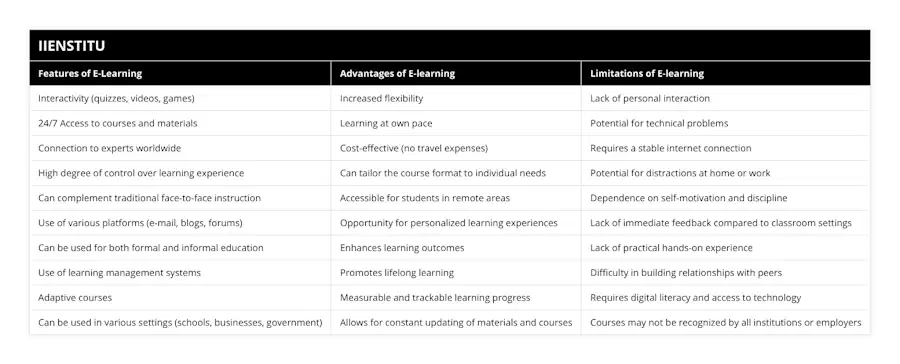
Frequently Asked Questions
How has e-learning changed the way we learn?
E-learning has changed the way we learn by increasing access to information and breaking down barriers to learning. It has also encouraged active and interactive learning, as well as making learning more engaging and fun.
Several studies have found that e-learning can lead to better academic performance. For example, a study by the Open University in the UK found that students who used e-learning performed 10% better on average than those who didn’t.
There are several reasons why e-learning may lead to improved performance. One is that it can provide just-in-time learning, which means that learners can access information and resources exactly when they need them. This is in contrast to traditional learning methods, where learners might have.
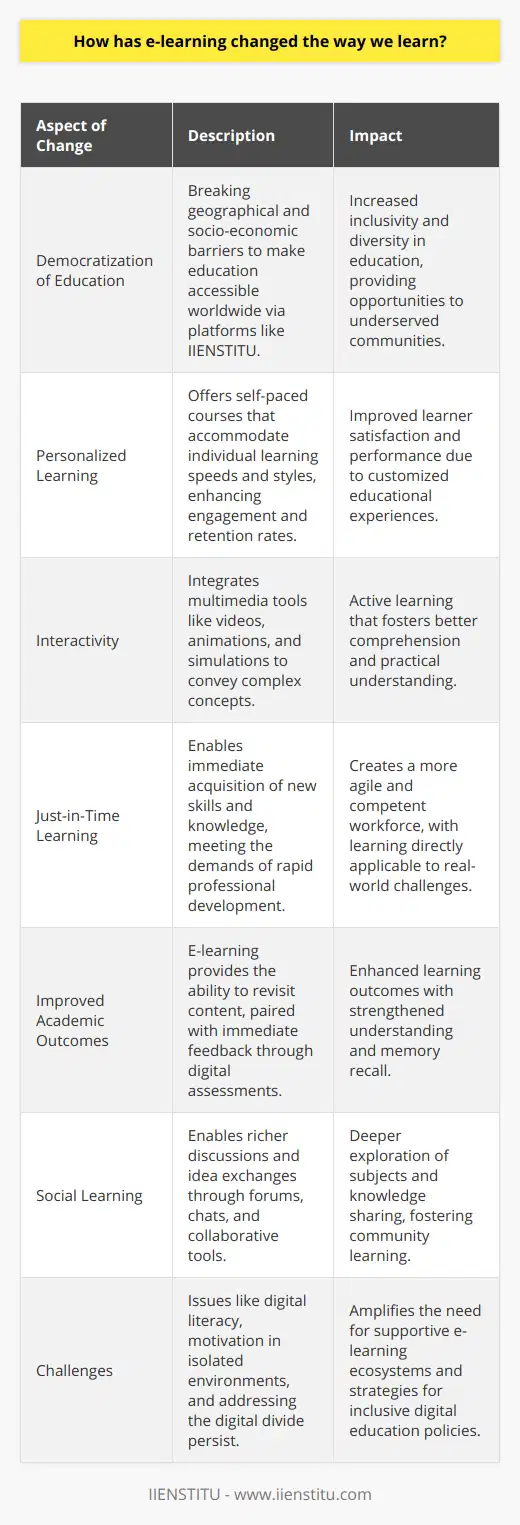
What subjects are best suited for e-learning?
There is no one-size-fits-all answer to this question, as the best subjects for e-learning will vary depending on the individual learner's needs and preferences. However, some general subject areas that are well suited for e-learning include business and finance, computer science and technology, health and medicine, and foreign languages.
Generally speaking, e-learning can be an extremely effective way to learn new information and master new skills. This is because e-learning can be customized to the individual learner's needs, pace, and learning style. Additionally, e-learning can be very convenient because it can be done anytime, anywhere.
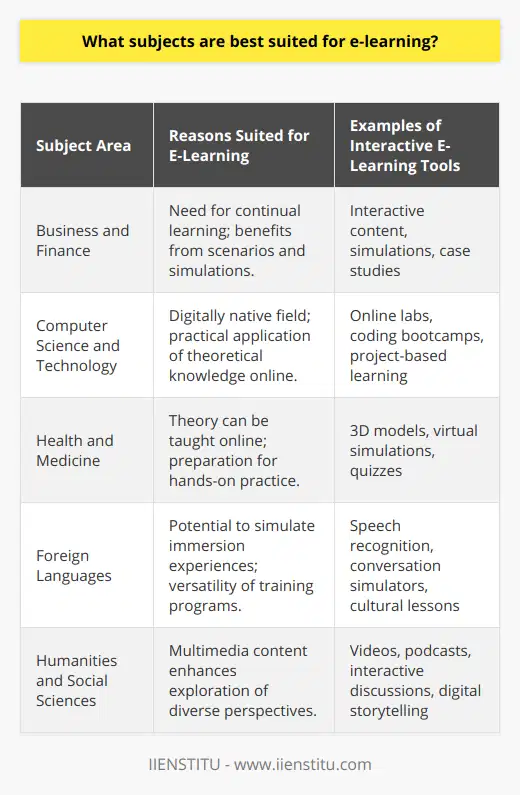
Are there any drawbacks to using e-learning?
There are a few drawbacks to using e-learning. First, it can be difficult to keep students engaged in the material when they're not in a traditional classroom setting. Second, some students may find it difficult to focus on the material when there are distractions (e.g., notifications from other apps, classmates talking) going on around them. Finally, not everyone is comfortable with learning in a digital environment.
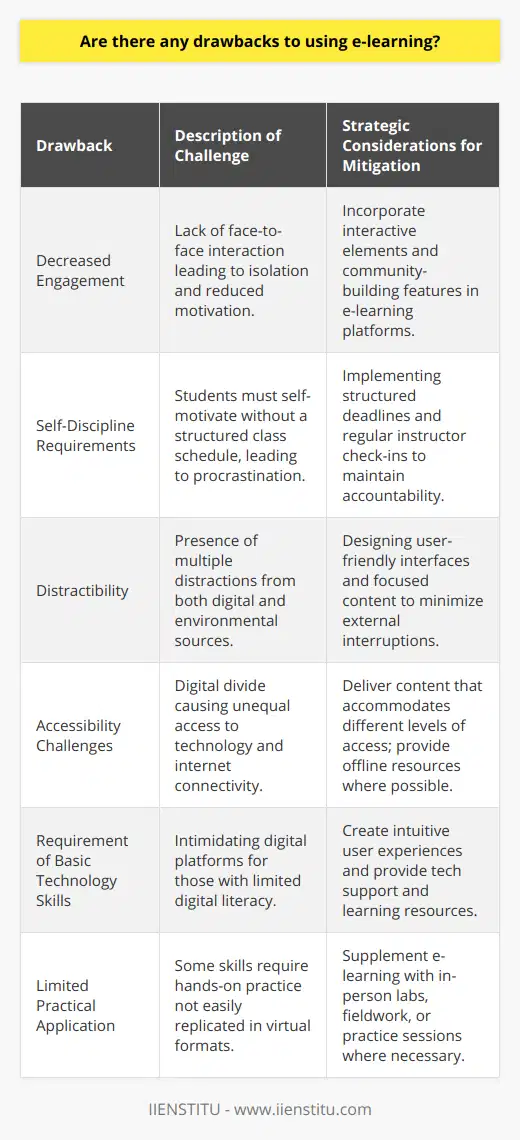
What is the impact of eLearning on accessibility and inclusivity in education?
Impact of eLearning on Accessibility
The advent of eLearning has significantly improved accessibility in education, making learning resources readily available to a wider audience. Digital platforms and online courses offer a level of convenience that traditional classrooms cannot match, as students can access materials anytime, anywhere, and from any device.
Promoting Inclusivity in Education
Inclusivity in education allows students with diverse backgrounds, abilities, and needs to participate equitably in learning experiences. eLearning enhances inclusivity by providing various instructional methods, such as video lectures, text-based content, and interactive modules, catering to different learning preferences. In addition, it enables educators to employ assistive technologies, such as screen readers and speech-to-text tools, aiding students with disabilities.
Supporting Learners' Autonomy
eLearning fosters learner autonomy by allowing students to work at their own pace and develop individualized learning paths. This flexibility is particularly beneficial for those juggling multiple responsibilities, such as work or family commitments, enabling them to achieve their educational goals without sacrificing other aspects of their lives.
Role of Universal Design
The universal design for learning (UDL) framework, often applied in eLearning, plays a key role in promoting accessibility and inclusivity. Its core principles - multiple means of representation, action and expression, and engagement - benefit all learners, particularly those with disabilities. By incorporating UDL in eLearning, educators create an environment where diverse learners can thrive and gain equal access to education.
Overcoming Digital Divide Challenges
Despite the many benefits of eLearning, one must consider the digital divide that still pervades our society. Lack of access to technology and internet connectivity, particularly in rural and low-income areas, can hinder eLearning's full potential for promoting accessibility and inclusivity. Acknowledging this challenge is vital, and concerted efforts to address digital inequalities should be prioritized to maximize eLearning's impact in education.
In conclusion, eLearning has greatly impacted accessibility and inclusivity in education by eliminating geographical constraints, offering flexible learning options, and embracing universal design principles. While there are still challenges related to the digital divide that need to be addressed, eLearning continues to be a powerful tool in advancing educational equity and opportunities for diverse learners.
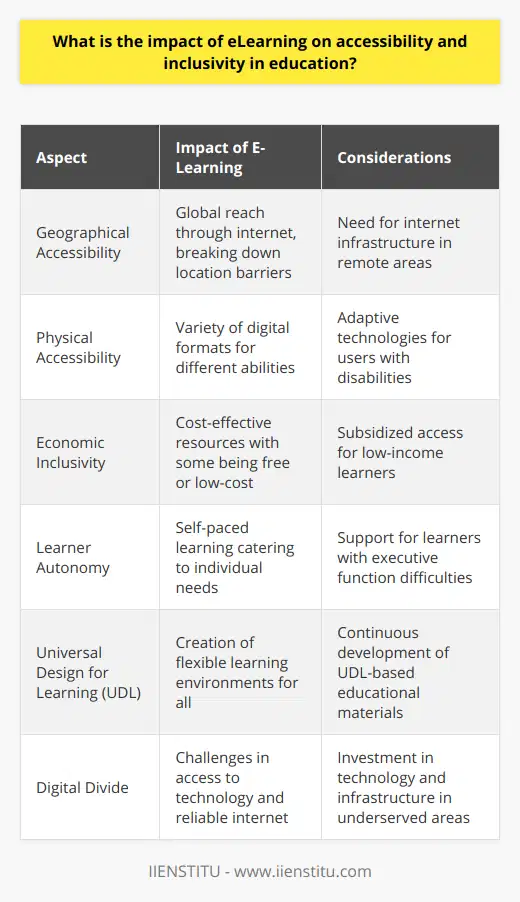
How do eLearning platforms ensure the quality and credibility of the content they provide?
Quality Assurance in Content Creation
To ensure the quality and credibility of the content they provide, eLearning platforms implement rigorous quality assurance processes during content creation. This often involves setting strict guidelines for content developers, such as following recognized instructional design principles and incorporating effective pedagogical practices to facilitate meaningful learning experiences. Additionally, user feedback plays a critical role in continuous improvement of eLearning content.
Expert Involvement and Validation
One key aspect of content credibility in eLearning platforms is the involvement of subject matter experts (SMEs) in the development process. SMEs contribute to the accuracy and relevance of content by providing in-depth knowledge and expertise on the given subject. Besides, these experts review and validate the content to ensure it aligns with established academic standards or industry expectations, thus maintaining its credibility.
Regular Content Updates
Staying up-to-date with the latest research findings, industry advances, and technological developments is essential in providing relevant eLearning content. Therefore, eLearning platforms ensure that their content creators monitor ongoing changes and trends in their respective fields and modify the courses, lessons, or modules accordingly. This continuous updating process allows learners to acquire current and applicable knowledge, contributing to the overall quality of the learning experience.
Incorporation of Multimedia Elements
Effective eLearning content often incorporates multimedia elements such as images, videos, and interactive activities to enhance cognitive processing, engage learners, and support various learning styles. Quality eLearning platforms rely on multimedia developers and instructional designers to create and optimize these elements, ensuring that they are both visually appealing and serve a clear educational purpose. This ultimately contributes to the overall quality and effectiveness of the content.
Learner Feedback and Analytics
eLearning platforms actively seek learner feedback and use analytics to assess the performance of their content. Feedback from learners enables content creators to identify any areas for improvement, such as unclear explanations or insufficient examples. Moreover, the use of analytics, such as tracking completion rates, quiz scores, and time spent on activities, provides insight into the effectiveness of the content and informs future iterations. This data-driven approach to quality assurance ensures that eLearning platforms deliver the highest possible value to their users.
In conclusion, eLearning platforms ensure the quality and credibility of their content by adhering to established instructional design principles, involving subject matter experts, regularly updating content, incorporating multimedia elements, and leveraging learner feedback and analytics. These strategies allow eLearning platforms to maintain a high standard of content, ultimately contributing to the overall effectiveness of online learning experiences.

What are the key factors to consider when choosing an eLearning platform to enhance personal or professional development?
Selection Criteria for eLearning Platforms
Platform Usability
Choosing an eLearning platform that offers a seamless, user-friendly experience is crucial for effective personal or professional development. It should provide easy access to materials, intuitive navigation, and clear instructions for learners to engage successfully.
Curriculum Quality
The quality of the eLearning content must be considered, as this determines the effectiveness of learning. Choose an eLearning platform that offers comprehensive, up-to-date, and well-structured courses that align with the learners' goals and industry standards.
Flexible Learning Options
For an eLearning platform to cater to diverse learners, it should provide flexibility in terms of pace, device compatibility, and learning preferences. Additionally, learners should have access to various content formats, such as video, audio, text, and interactive elements.
Assessment and Feedback
Effective eLearning platforms should offer robust assessment tools and personalized feedback mechanisms to enable learners to measure their progress continually. This also allows instructors to identify areas for improvement and tailor their support accordingly.
Social and Collaborative Learning
An eLearning platform should foster a sense of community and collaboration, enabling learners to share knowledge, exchange ideas, and engage in group activities. This not only enhances learning outcomes but also helps develop valuable interpersonal skills.
Customizability and Scalability
A suitable eLearning platform should be customizable to cater to unique learning needs and scalable to accommodate growing demands. This allows for personalization of the learning experience and expansion of the platform as needed.
Technical Support and Security
Strong technical support ensures any technical issues, and security concerns are promptly resolved, contributing to a smooth learning experience. Select an eLearning platform that offers swift assistance and prioritizes data privacy and security.
Cost-Effectiveness
Lastly, it is important to consider the cost-effectiveness of an eLearning platform. Weigh the benefits provided against the investment required, taking into account any hidden fees, such as content updates or ongoing support.
In conclusion, to enhance personal or professional development through an eLearning platform, prioritize factors such as platform usability, curriculum quality, flexible learning options, assessment and feedback mechanisms, social and collaborative learning experiences, customizability and scalability, technical support and security, and cost-effectiveness. These considerations ensure a comprehensive, engaging, and valuable learning experience that meets the needs of diverse learners.
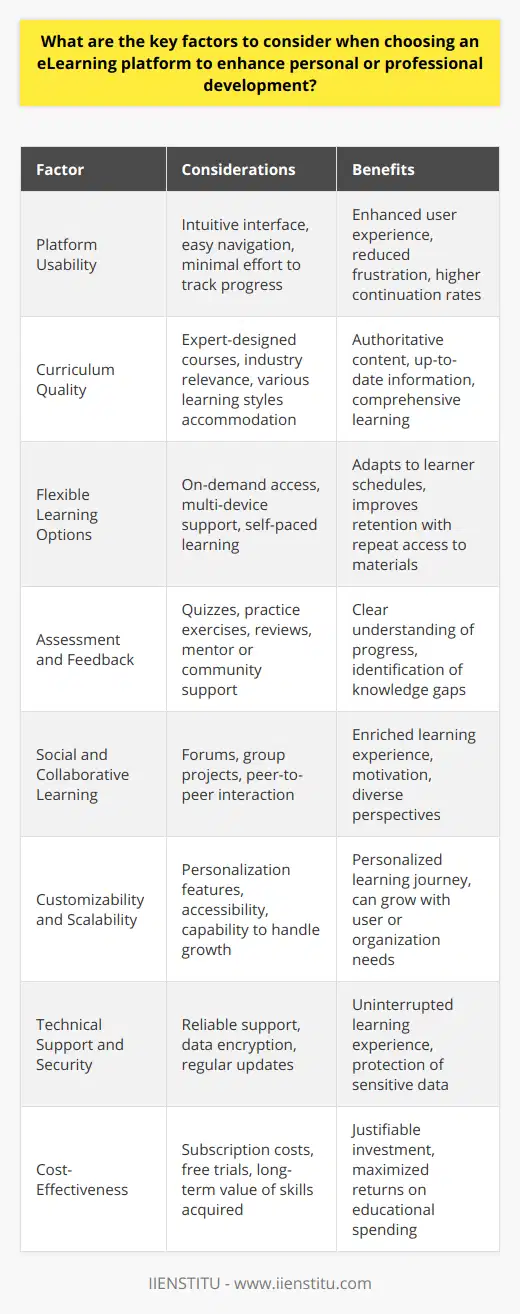
What is the underlying pedagogy behind eLearning and its effectiveness in various learning contexts?
Underlying Pedagogy of eLearning
The underlying pedagogy behind eLearning entails the integration of technology, learner-centered approaches, and diverse instructional strategies to facilitate knowledge acquisition and skill development. Through this approach, learners are empowered to construct their understanding, self-direct their learning journey, and engage with peers in a collaborative manner.
Effectiveness in Different Learning Contexts
In formal education settings, eLearning can complement traditional classroom instruction by enabling the use of multimedia, interactive content, adaptive assessments, and personalized learning paths. In such contexts, eLearning has proved to be effective in enhancing students' engagement, motivation, and learning outcomes.
Workplace Training and Development
For workplace training and professional development, eLearning offers cost-effective and flexible solutions. In this context, virtual simulations, scenario-based tasks, and self-paced modules can help employees to acquire new skills, reinforce existing ones, and stay up-to-date with industry trends. Moreover, eLearning platforms can track performance metrics, thereby enabling organizations to monitor their employees' progress and tailor future training initiatives accordingly.
Lifelong Learning Pursuits
eLearning is highly advantageous for lifelong learners who seek continuous personal and professional growth. Open educational resources, Massive Open Online Courses (MOOCs), and online learning communities cater to the diverse learning needs, interests, and schedules of individuals. Efficacy in this context often relates to the ease of access, flexibility, and affordability of eLearning opportunities, as well as the extent to which they enhance the learners' knowledge, competence, and confidence.
Global Access and Inclusivity
In various contexts, eLearning can contribute to greater accessibility and equity in education. Particularly in regions with limited resources, eLearning platforms can bridge the gap by providing quality instructional materials, globally-renowned expertise, and opportunities for cross-cultural collaboration. Consequently, evidence suggests that eLearning can contribute to improved educational outcomes in less privileged environments and facilitate social and economic mobility.
In conclusion, eLearning is founded in a pedagogy that prioritizes learner autonomy, technological innovation, and diverse learning styles. Its effectiveness in various learning contexts can be attributed to factors such as engagement, convenience, affordability, and equity. As digital technologies continue to evolve and revolutionize the educational landscape, it is essential for stakeholders to understand the pedagogical principles behind eLearning and optimize its benefits across multiple settings.
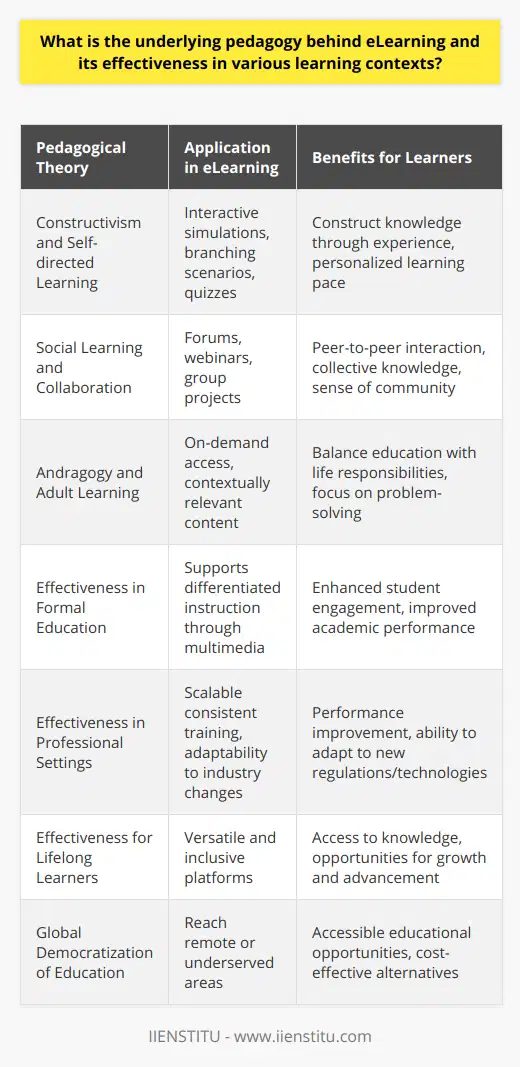
How do eLearning environments foster collaboration and social learning among learners?
Benefits of eLearning Environments
eLearning environments provide various benefits, including fostering collaboration and social learning among learners. The utilization of advanced technology, such as virtual classrooms, discussion boards, and instant messaging, facilitates the exchange of knowledge, ideas, and experiences. Such platforms encourage learners to actively engage with their peers, contributing to a deeper understanding of the subject matter.
Interactive Learning Tools
One of the critical aspects of eLearning environments is the availability of interactive learning tools. These tools, such as multimedia presentations, online quizzes, and simulations, allow learners to work together and share resources. Collaborative activities such as group projects enable learners to develop teamwork skills, problem-solving abilities, and critical thinking.
Diverse Perspectives
Diversity among learners in eLearning environments enriches the learning experience by promoting the sharing of different perspectives and opinions. This cultural exchange is a significant contributor to social learning, enabling learners to acquire a broader understanding of global issues and develop empathy for different cultures.
Participatory Learning
In eLearning environments, a higher degree of participatory learning is possible, as learners can contribute and engage meaningfully in the learning process. Contributions in the form of peer feedback, peer assessments, and forum discussions help develop communication skills, respect for diverse opinions, negotiation strategies, and leadership skills.
Inclusive Learning Community
eLearning environments allow the creation of an inclusive learning community, where learners with different abilities, backgrounds, and learning preferences can access educational materials and resources. Flexible learning environments, such as the ability to access learning materials at any time, nurture collaboration and social learning by minimizing barriers to participation.
In summary, eLearning environments play an essential role in fostering collaboration and social learning among learners. These environments provide interactive learning tools, encourage a diverse sharing of perspectives, promote participatory learning, and create an inclusive learning community where learners can actively engage and learn from one another.

What are the ethical considerations surrounding eLearning, particularly in regard to data privacy and addressing digital divides?
Ethical Considerations in eLearning
In recent years, eLearning has become an increasingly popular and essential approach to education. As it gains traction, several ethical considerations must be taken into account. In particular, data privacy and addressing digital divides pose significant challenges that must be addressed in order to ensure eLearning remains both a viable and responsible educational tool.
Data Privacy in eLearning
Data privacy is a crucial aspect of eLearning, as it deals with the protection of students' personal information. Institutions must carefully consider how they collect, store, and handle the data generated through eLearning platforms. This includes adhering to relevant data protection laws and ensuring that students are aware of their rights in regards to their data. In addition, eLearning programs should incorporate robust security measures to prevent unauthorized access or misuse of sensitive information.
Another critical aspect of data privacy in eLearning is consent. Students should have the choice to opt-in or opt-out of data collection and be aware of the potential risks and benefits associated with sharing their information. Educators and institutions should be transparent about their data collection practices and provide students with the proper agency to make informed decisions about their privacy.
Addressing Digital Divides in eLearning
A digital divide refers to the gap between individuals or communities with access to digital technologies and those without. eLearning programs must be diligent in addressing digital divides to ensure equal educational opportunities for all students. This can be achieved by tailoring eLearning content to cater to a wide range of technological capabilities, fostering inclusivity for students with limited access.
Moreover, educational institutions should work to improve accessibility to eLearning programs for underserved populations. This could involve partnering with local organizations that provide digital resources or exploring alternative means of delivering eLearning content, such as offline or low-bandwidth options. Additionally, providing training and support to help students navigate eLearning platforms is vital in bridging the digital gap and preventing disadvantaged students from falling behind.
Conclusion
As eLearning continues to grow, ethical considerations such as data privacy and addressing digital divides are of paramount importance. Ensuring that eLearning experiences are accessible to all students while maintaining a high level of data protection helps promote a responsible and inclusive approach to education. By addressing these ethical concerns, eLearning has the potential to revolutionize the education sector and foster a more equitable learning environment worldwide.
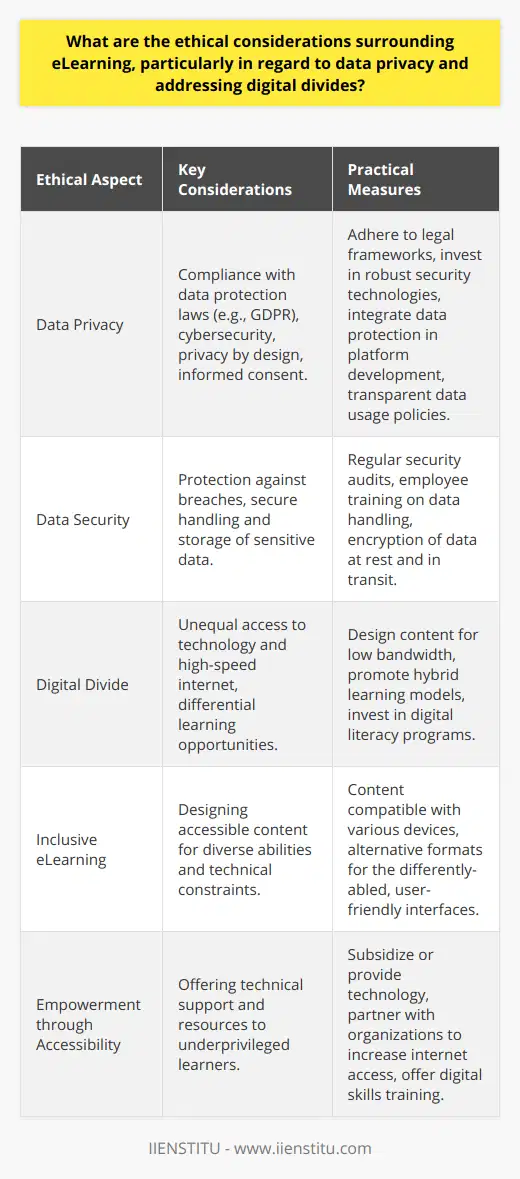
What is the relationship between eLearning and traditional classroom learning in terms of academic outcomes and engagement?
Comparing eLearning and Traditional Classroom Learning
In the context of academic outcomes and engagement, the relationship between eLearning and traditional classroom learning is a matter of significant debate. Various studies have attempted to investigate this connection from different angles.
Effect on Academic Outcomes
Research has demonstrated that both eLearning and traditional classroom environments can lead to comparable academic outcomes when appropriately designed and implemented. In some cases, eLearning has even outperformed traditional classrooms in terms of learning outcomes for students. This success can be attributed to factors such as flexibility, adaptability, and the ability to tailor content towards individual students' needs.
Role of Student Engagement
The level of student engagement is critical in determining academic achievement. While traditional classroom learning typically encourages face-to-face, real-time interaction between students and instructors, eLearning often relies on asynchronous communication and self-paced learning. In asynchronous eLearning environments, students engage with content at their convenience, which may lead to higher levels of cognitive engagement than traditional classroom settings.
Personalizing Learning Experiences
One advantage eLearning has over traditional classroom learning is its potential for personalization. Customization in eLearning allows each student to learn at their own pace, addressing individual learning needs and accommodating various learning styles. This targeted approach can lead to more effective engagement and improved academic outcomes.
Blended Learning Approach
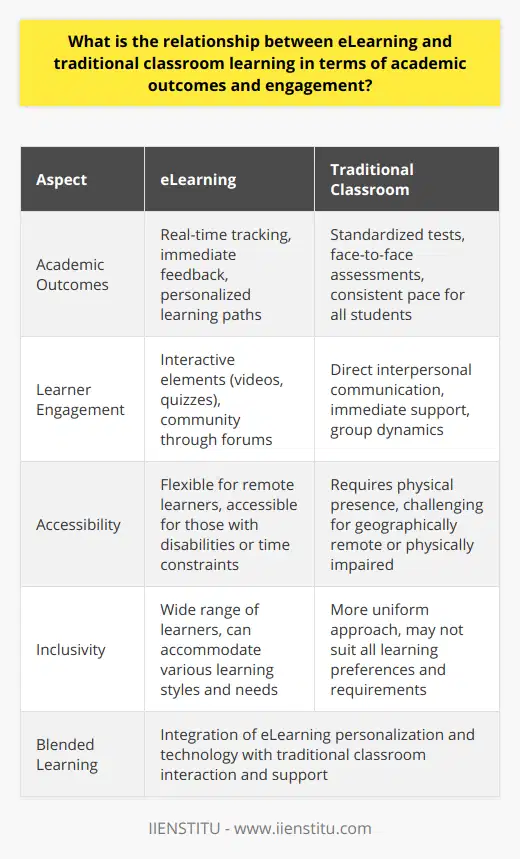
How do eLearning platforms address various learning styles and individual preferences for an optimal learning experience?
Addressing Learning Styles through eLearning Platforms
eLearning platforms offer a wide range of features that enable learners to access their preferred learning styles. By providing various content formats such as text, videos, podcasts, and interactive simulations, these platforms cater to diverse learner preferences. This allows individuals to choose materials that align with their unique learning styles, leading to an enhanced educational experience.
Customization and Personalization
One of the significant advantages of eLearning platforms is the ability to customize and personalize learning experiences. This includes adjusting content delivery methods, assessments, and feedback to meet individual needs. By offering such personalized learning pathways, learners can engage with the material in a way that best suits their preferences and cognitive strengths.
Interactive and Collaborative Learning
eLearning platforms also emphasize the importance of interactive and collaborative learning experiences. Many platforms incorporate gamification, problem-solving scenarios, and real-time collaboration tools within their offerings. These features encourage learners to participate actively in the learning process, promoting exploration and discovery. This leads to better knowledge retention and the development of critical thinking skills.
Adaptive Learning Technologies
In addition to accommodating diverse learning styles, eLearning platforms often employ adaptive learning technologies. These sophisticated algorithms assess learners' performance and adapt content delivery and pacing based on their progress. By providing a more individualized learning experience, learners can focus on their areas of improvement, further enhancing their comprehension and skill development.
Flexible and Accessible Learning Environment
Finally, eLearning platforms provide a flexible and accessible learning environment for individuals with varying educational backgrounds, abilities, and schedules. By offering courses that are available 24/7, learners can access the content at their own pace and according to their personal preferences. This flexibility is crucial for providing an optimal learning experience tailored to each individual's unique needs.
In conclusion, eLearning platforms successfully address various learning styles and individual preferences by offering customizable content, promoting interactive and collaborative learning experiences, implementing adaptive learning technologies, and providing a flexible and accessible learning environment. These features contribute to creating an optimal learning experience, leading to greater success and satisfaction for learners.
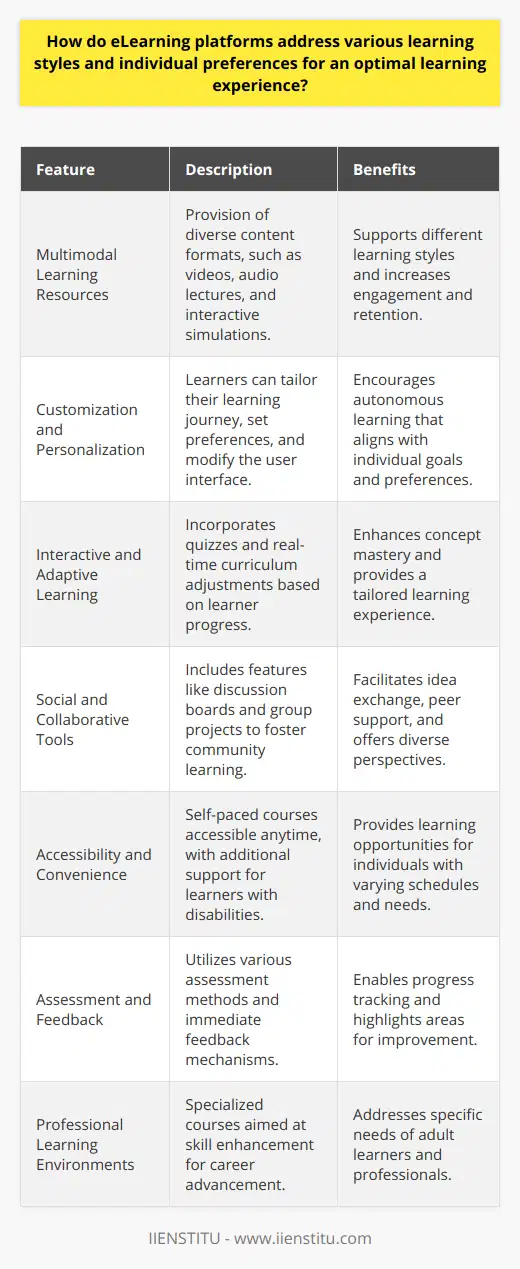
What role do emerging technologies, such as Artificial Intelligence and Virtual Reality, play in shaping the future of eLearning and enhancing its effectiveness?
The Role of Artificial Intelligence in eLearning
Emerging technologies, such as Artificial Intelligence (AI) and Virtual Reality (VR), play a crucial role in shaping the future of eLearning and enhancing its effectiveness. AI, for example, enables personalized learning experiences by analyzing student data and preferences. This technology can adapt content delivery to suit individual needs, providing a more targeted and efficient learning process.
Incorporating Virtual Reality in Education
VR, on the other hand, offers immersive learning experiences that can greatly improve knowledge retention. By simulating real-world scenarios, students can practice skills and explore concepts in an engaging manner. This hands-on approach promotes active learning, making it easier for students to understand complex topics and apply their knowledge effectively.
Augmenting Learning Through Gamification
Furthermore, gamification, a technique that utilizes game elements in non-gaming contexts, can also contribute to improved eLearning outcomes. When combined with AI and VR, gamification can create a more enjoyable and rewarding learning experience, fostering motivation and increasing student engagement. The integration of these technologies can therefore lead to higher retention rates and better performance.
Accelerating Learning with Adaptive Learning Systems
AI-powered adaptive learning systems can provide immediate feedback, helping students identify areas that require improvement. This real-time guidance encourages self-assessment and enables timely corrective action, enhancing the overall learning experience. Moreover, adaptive learning systems can track progress and adjust content based on individual performance, ensuring that the learning experience remains relevant to each student's needs and abilities.
Promoting Collaborative Learning Through Virtual Worlds
Lastly, virtual worlds can facilitate collaborative learning, allowing students to interact with peers and instructors remotely. This technology breaks geographical barriers, enabling global collaboration and fostering diverse perspectives in problem-solving and creative thinking. Students can thus benefit from a shared pool of knowledge and experiences, enriching their learning experience beyond traditional classroom settings.
In conclusion, emerging technologies such as AI and VR are playing a pivotal role in redefining the future of eLearning. Their integration into educational platforms can result in highly personalized, engaging, and effective learning experiences that cater to the evolving needs of learners and enhance the overall effectiveness of eLearning.
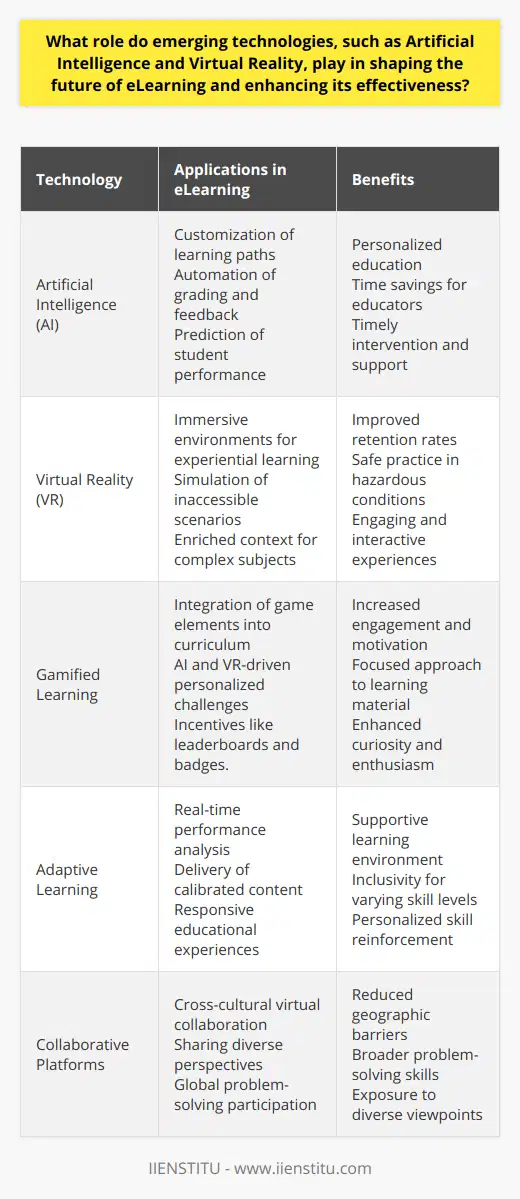
What are 3 types of eLearning?
eLearning Methods: Synchronous, Asynchronous, and Blended
The first type of eLearning is synchronous learning. Synchronous learning happens in real-time, often through digital platforms. Learners and educators interact and engage with the material at the same time, typically through web conferencing, videoconferencing, or live chatting. This allows for immediate feedback and dynamic interaction, resembling traditional classroom learning but in a digital environment.
The second type of eLearning is asynchronous learning. Asynchronous learning does not require real-time interaction. Instead, learners can access and engage with the course material at their own pace, without the need for simultaneous participation. This flexibility accommodates different learning styles and schedules, relying on resources like prerecorded video lectures, quizzes, discussion boards, and digital documents.
Finally, there is blended learning, which wisely combines elements of both synchronous and asynchronous learning. This model allows for some real-time interaction and immediate feedback through synchronous sessions, while also providing the flexibility of asynchronous learning methods. Learners can thus absorb information at their own pace while maintaining a certain level of engagement with facilitators and peers.
To conclude, these three types of eLearning, synchronous, asynchronous, and blended, each offer unique advantages to suit different learning needs and preferences. As the digital age continues to evolve, we can anticipate further transformation and diversification in eLearning methods.
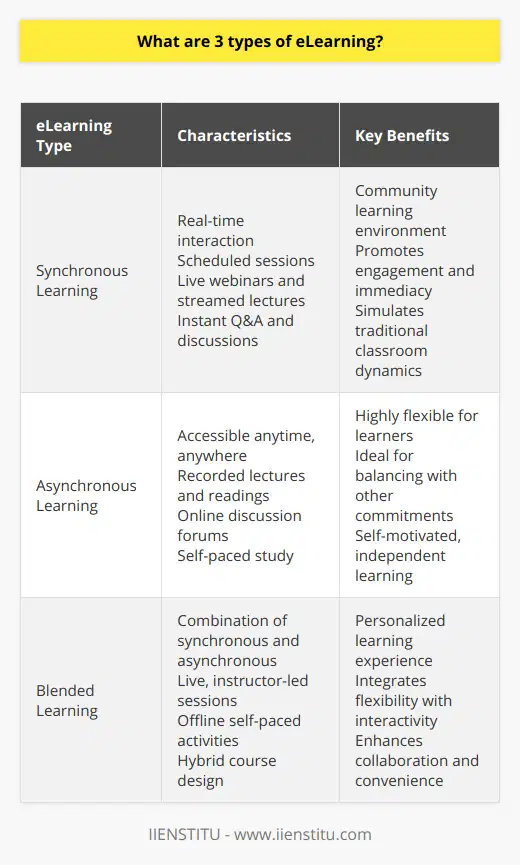
What do you mean by education anytime, anywhere?
Understanding the Concept
Education anytime, anywhere refers to a learning paradigm that transcovers limitations of traditional schooling. It emphasizes learning beyond the physical establishments; school premises or universities.
Technological Influence
Technologically advanced learning systems allow us to experience this model. Accessibility advances enable individuals to learn irrespective of their geographical location or time constraints.
Online Learning Platforms
Today, numerous online platforms offer a wide range of courses. These e-learning platforms, like Khan Academy or Coursera, allow global access and exist outside the traditional academic schedule.
Democratizing the Learning Process
Correspondingly, this type of education democratizes the learning process. It creates an inclusive system, breaking any barriers of geography, financial constraints, or rigid time slots.
Digital Learning Materials
Furthermore, educational resources like digital books, articles, podcasts, webinars, and interactive materials make it possible to learn anytime, anywhere. Freedom to pace the learning process empowers learners and enhances understanding.
Self-paced Learning
The concept calls for self-paced learning as well. Learners can move through course materials at their own speed, tailoring their education to suit personal needs or commitments.
Inclusive Learning for all
This learning model embraces all demographics. It provides opportunities for young learners, working professionals, or people in their late years to acquire new knowledge or skills.
Final Takeaway
To conclude, Education anytime, anywhere is a flexible, inclusive, and accessible learning model. It encourages lifelong learning and opens up new opportunities for individuals worldwide.
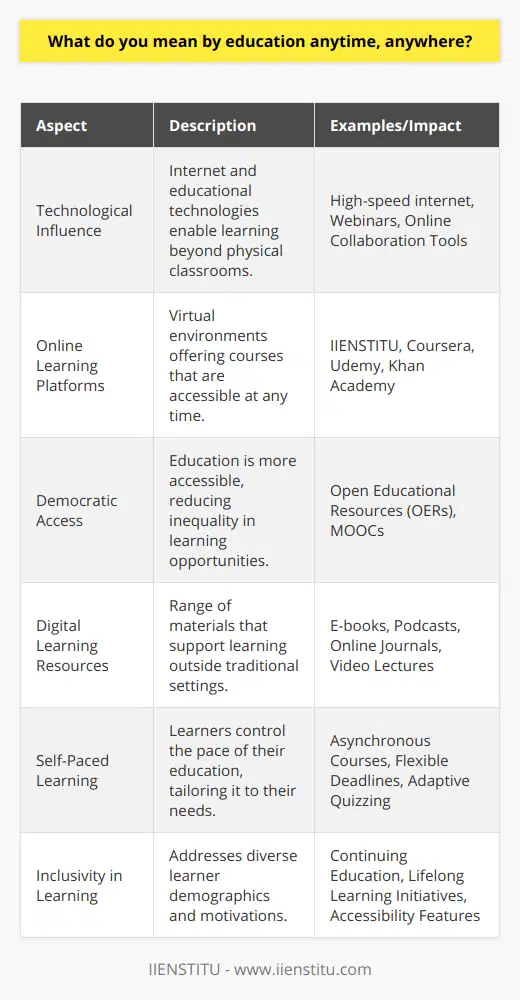
Is eLearning the same as an online class?
Understanding the Distinctions
eLearning and online classes are not the same. They represent two distinct forms of digital education, despite often being wrongly interchanged.
Definition of eLearning
eLearning, short for electronic learning, refers to an umbrella term encompassing all types of learning that take place through digital platforms. This includes, but is not limited to online courses, webinars, videos, audios, quizzes, and digital textbooks. Essentially, it involves using electronics, particularly the internet, to facilitate the learning process.
Online Classes Explained
On the other hand, online classes, also often called online courses, constitute a specific form of eLearning. They are structured programs designed with a clear learning path. Online classes have specific start and end dates, syllabi, instructors, and grades, mirroring traditional face-to-face classrooms but conducted virtually.
The Major Distinctions
The major dissimilarities between eLearning and online classes lie in their structure and flexibility. eLearning is more fragmented, self-paced, and flexible, whereas online classes follow a fixed schedule and structure, often requiring synchronous participation.
Bridging the Gap
While their distinctions are clear, online classes and eLearning share a common goal: providing accessible, convenient, and flexible education. Students can benefit from both, selecting according to their learning pace, style, and needs. Hence, the amalgamation of both creates a dynamic and versatile educational environment, ensuring optimal learning outcomes.
In conclusion, while eLearning and online classes might seem similar, they represent different aspects of digital education. One should not overlook their differences, and understanding these nuances helps create more effective learning experiences.
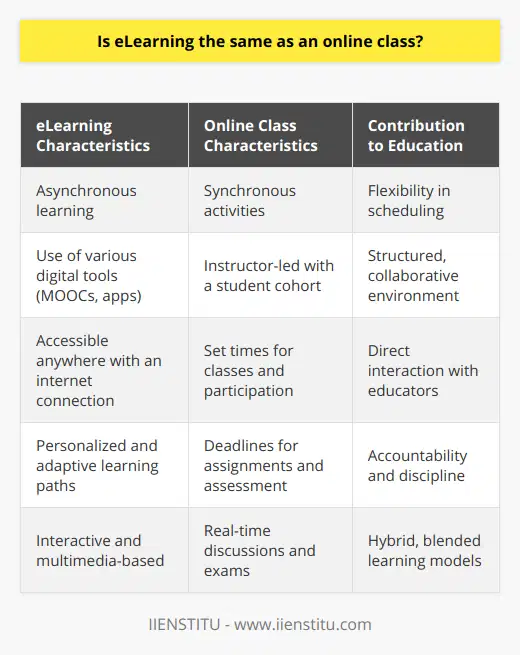
What is the meaning of eLearning?
Defining eLearning
Essential to many educational and professional training contexts, eLearning refers to the utilization of electronic technologies. These technologies facilitate access to educational curriculum outside of a traditional classroom. In most cases, it refers to a course, program or degree delivered completely online.
Characteristic Features of eLearning
eLearning is characterized by the geographic freedom it affords its participants. Thus, students or trainees can participate from virtually any location. All that is required is a reliable internet connection and a digital device such as a laptop or smartphone.
Technological Platforms and eLearning
Various digital platforms support the effective delivery of eLearning. These range from content management systems to video-conferencing tools, collaborative platforms, and more. These platforms connect learners and instructors, fostering an interactive learning environment.
Content Types in eLearning
eLearning incorporates multiple forms of content, enhancing the learning experience. This content includes text, audio, video, and interactive activities. These diverse forms ensure the engagement of different types of learners, catering to varied learning styles.
Advantages of eLearning
One noteworthy advantage of eLearning is flexibility. It allows learners to progress at their pace, catering to individual learning speed and style. Additionally, it is often more cost-effective than traditional learning methods being devoid of commuting and accommodation expenses.
Importance of eLearning
In the 21st century, eLearning plays a key role in democratizing education and training. It makes learning resources more widely available, breaking down geographical, socio-economic and physical barriers. It is a powerful tool for lifelong learning, upskilling, and professional development.
In conclusion, eLearning, through its diverse, flexible and accessible digital platforms, transforms traditional learning landscapes. It enables engaging and effective learning experiences, that transcend geographical and time restrictions. The importance of eLearning is thus evident in today's increasingly interconnected and technology-driven world.
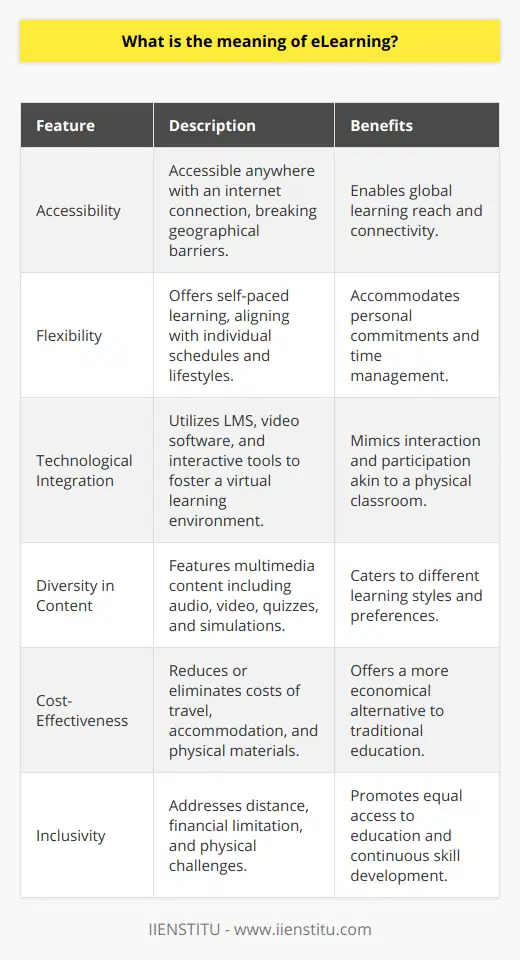
Is eLearning the same as online class?
Defining eLearning and Online Class
Though people often use the terms 'eLearning' and 'online class' interchangeably, they are not exactly the same. eLearning refers to a broad concept that includes any form of learning that utilizes electronic technologies. This can range from educational websites to computer applications used for learning purposes.
Characteristics of eLearning
eLearning can be both synchronous (occurring in real-time, like a webinar) and asynchronous (non-time specific, like pre-recorded lessons or online discussion boards). It can also be self-paced, giving learners the flexibility to absorb content at their own speed.
Understanding Online Classes
Online classes, on the other hand, are a subset of eLearning. They represent an organized, structured learning experience delivered entirely over the internet. In an online class, you typically have a set curriculum, a specific start and end date, and an instructor leading the course. The educational institution itself often accredits it, and upon successful completion, students generally receive a certificate or degree.
Key Features of Online Classes
Online classes are usually more structured. They follow a specific learning path, have a timetable for delivering content, and have established interaction points between students and instructors. There occasionally are assessments and grading as well, simulating the traditional classroom experience in a virtual environment.
In conclusion, while eLearning is a broader term that encompasses numerous digital learning methods, online classes represent a more structured and formalized subset of eLearning. Both extend the reach and accessibility of education, but each has its unique characteristics.
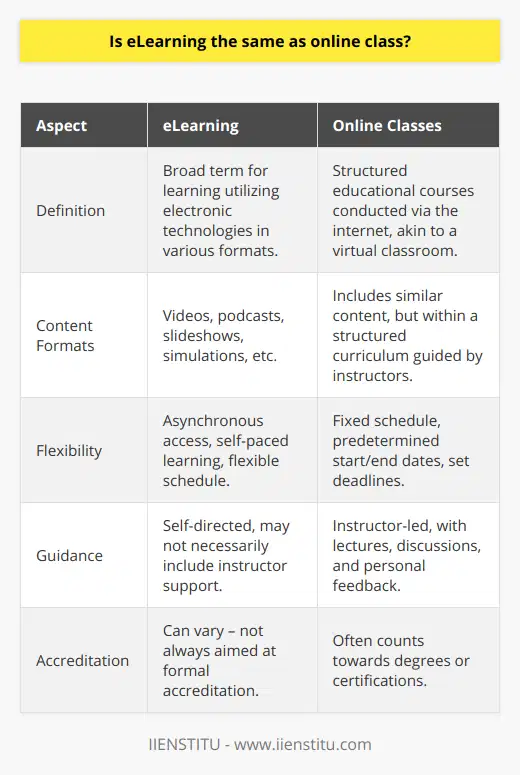
What is the meaning of anytime learning?
Understanding Anytime Learning
Anytime learning refers to an educational approach. This approach utilizes digital tools and platforms. It allows learners to access knowledge on demand.
Flexibility of Anytime Learning
Anytime learning stands out due to its flexibility. Learners have control over when they engage in their studies. This lack of time constraints enables one to balance responsibilities.
Advantages of Anytime Learning
The convenience of anytime learning encourages continuous education. Learners can study at their own pace without feeling pressured. Furthermore, they can revisit topics whenever necessary for better understanding.
The Role of Digital Platforms
Digital platforms play a critical role in anytime learning. They provide access to numerous resources. These include videos, articles, e-books, and discussion forums. Hence, learners have various options for gaining knowledge.
Tailored Learning Experience
Anytime learning allows for a personalized education experience. Individuals can focus on areas they find challenging. At the same time, they can skip or fast-track concepts they have already grasped.
Overcoming Traditional Limitations
Distance and time no longer challenge learners. They can progress with their education despite geographical limitations. This democratizes education, offering equal opportunities to learn.
Conclusion: Future of Learning
To sum up, anytime learning is a flexible, personalized approach to education. It overcomes the traditional limitations of time and space. Its future looks promising, ushering in a new era of democratized, accessible education.

What are the key components of a successful e-learning program?
Underlying Pedagogical Concepts
A successful e-learning program first aligns to sound pedagogical concepts. These educational theories should guide the design and delivery of online content to facilitate learning effectively.
Quality Content Production
The heart of e-learning lies in its content. Professionals in the field must produce the curriculum, ensuring it meets the learning objectives. High-quality content engages learners and promotes retention.
Interactive Instruction
Active learning shapes most successful e-learning experiences. This component involves interactive instruction, whether through video lectures, multimedia presentations, or exploratory activities. Interactive instruction supports learning engagement.
Assessment and Tracking
Assessments serve as essential components, providing necessary feedback to learners and instructors. Assessment tools help to evaluate learner's understanding of the content. Learner tracking enables instructors to identify the learner's strengths and areas of improvement.
Collaborative Learning Environment
The program should foster a collaborative learning environment. Discussion forums, group projects, and peer reviews encourage interaction and knowledge exchange. This collaboration helps to develop a sense of community among remote learners.
Accessible Learning
The program must be accessible to all learners, regardless of their geographical location, digital literacy, or physical disabilities. Accessibility includes the use of responsive design, closed captions, and screen reader-friendly content.
Technical Support
Reliable technical support facilitates a smooth online learning experience. Support services should quickly address technical issues to prevent disruption of the learning process.
Finally, continuous program evaluation enables updates and improvements. This regular assessment ensures the program remains current and effective. Overall, the core components of a successful e-learning program combine to create a comprehensive, accessible, interactive, and engaging learning experience.
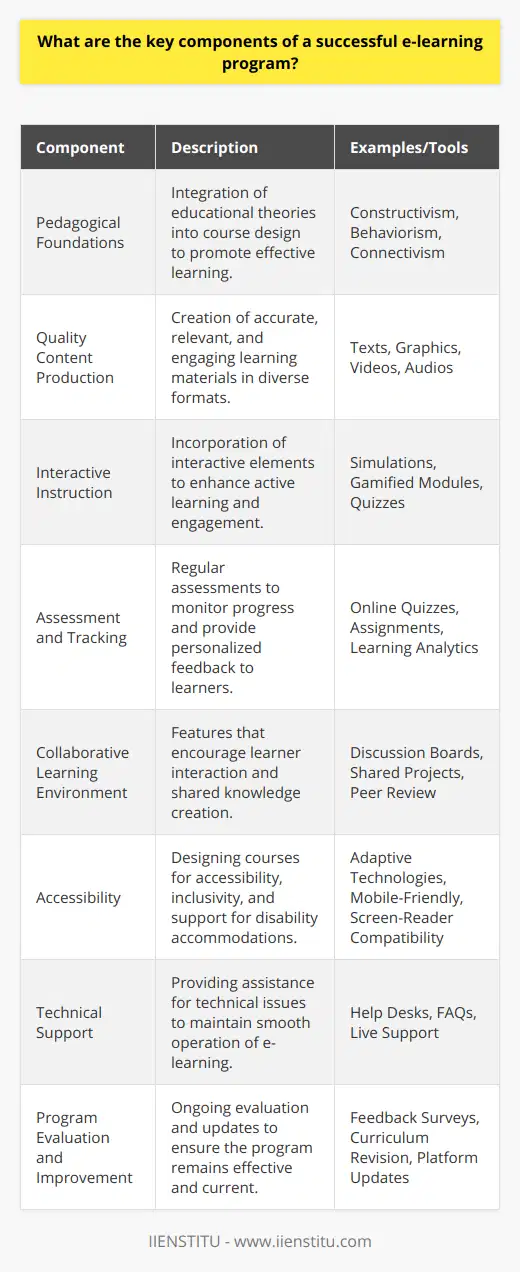
How do e-learning platforms assess and track learner progress and performance?
E-learning Platforms Approach to Assessment
E-learning platforms deploy various methods to evaluate and monitor learner progress. Quizzes or tests are common tools. Mostly, these assess the student's understanding of a topic at the end of a lesson or module. The system records the results, providing necessary data to track progress over time.
Applying Analytics to Monitor Performance
Many e-learning platforms use sophisticated analytics. The platforms collect user activity data such as time spent on a task, completion rates, and much more. Analyzing this data offers an understanding of learner performance and engagement with the materials.
Incorporating Adaptive Learning Techniques
Adaptive learning techniques are also employed in some platforms. These can adjust the difficulty or type of content based on learner's performance. For example, a learner struggling with a topic may receive additional practice problems. Conversely, a successful student can be challenged with more advanced content.
Infusing Real-time Feedback Mechanisms
Real-time feedback is another tool used by these platforms. With the help of artificial intelligence, learners are given instant feedback on their performance. This highlights areas for improvement, strengthens learner's understanding, and fosters a more personalized learning experience.
Crowdsourcing for Peer Review
Peer review is also prevalent in many e-learning platforms. Here, learners review and assess each other's work. This is an excellent method for improving critical thinking and communication skills. It also gives students a different perspective on their learning.
E-learning platforms, therefore, use a combination of strategies to evaluate learner progress. From quizzes and sophisticated analytics, to adaptive learning and peer reviews, these platforms continuously monitor and track learner progress and performance. The goal is to provide a customized, effective learning experience for all users.

In what ways can e-learning be integrated with traditional face-to-face teaching methods for a blended learning approach?
Integrating E-Learning Elements
One way to create a blended learning environment is by integrating e-learning elements into face-to-face teaching. Teachers can utilise these digital resources to reinforce or expand on their in-class lessons. Here, digital learning supplements traditional teaching rather than replacing it.
Implementing Flipped Classroom Model
Another strategy is the flipped classroom model. Under this approach, students would do their learning online at home and then come to school to discuss what they learned, solve problems, and perform practical tasks. In this model, face-to-face classroom time is dedicated to collective problem-solving and collaborative learning.
Enabling Self-Paced Learning
A blended learning approach in such a set-up can help facilitate self-paced learning. This means a student can learn at their pace with support from the teacher when needed. This fosters self-reliance and self-confidence in their ability to learn and master new concepts.
Initiating Interactive Learning
Using classroom response systems or quizzes during the face-to-face sessions can make learning more interactive. These technologies also offer immediate feedback, which is crucial for students' learning process.
Enhancing Communication
Teachers can also use e-learning platforms for communication purposes, such as updating students on important class information or providing performance feedback. This enables continuous learning while facilitating enhanced teacher-student interaction, making learning more efficient.
Adapting the Curriculum
Lastly, e-learning can be integrated into traditional face-to-face methods by adapting the curriculum to fit the blended learning environment. Digital activities and resources must align with corresponding curriculum objectives, ensuring that technology enhances, rather than distracts from, the learning process.
In conclusion, teachers can integrate e-learning with face-to-face teaching by employing various strategies to create a blended, efficient learning environment that works best for all learners. Incorporating technology in teaching does not mean replacing traditional methods; rather, it is a supplement that enhances the learning experience.
